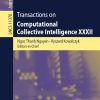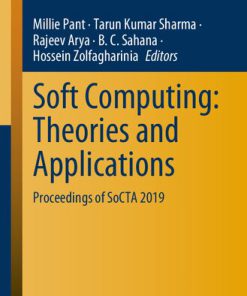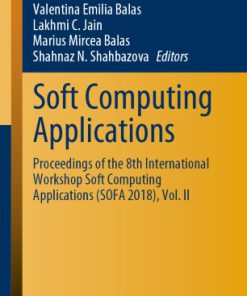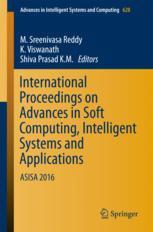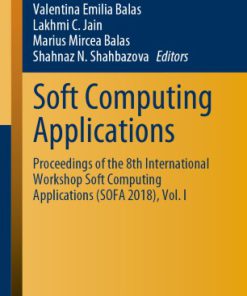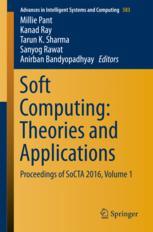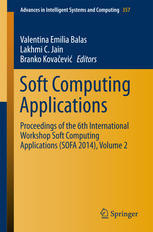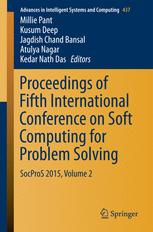Soft Computing Applications Proceedings of the 7th International Workshop Soft Computing Applications 1st Edition by Valentina Emilia Balas, Lakhmi Jain, Marius Mircea Balas ISBN 3319625233 9783319625232
$50.00 Original price was: $50.00.$25.00Current price is: $25.00.
Soft Computing Applications: Proceedings of the 7th International Workshop Soft Computing Applications 1st Edition by Valentina Emilia Balas, Lakhmi C. Jain, Marius Mircea Balas – Ebook PDF Instant Download/Delivery: 3319625233, 978-3319625232
Full download Soft Computing Applications: Proceedings of the 7th International Workshop Soft Computing Applications 1st Edition after payment

Product details:
ISBN 10: 3319625233
ISBN 13: 978-3319625232
Author: Valentina Emilia Balas, Lakhmi C. Jain, Marius Mircea Balas
These two volumes constitute the Proceedings of the 7th International Workshop on Soft Computing Applications (SOFA 2016), held on 24–26 August 2016 in Arad, Romania. This edition was organized by Aurel Vlaicu University of Arad, Romania, University of Belgrade, Serbia, in conjunction with the Institute of Computer Science, Iasi Branch of the Romanian Academy, IEEE Romanian Section, Romanian Society of Control Engineering and Technical Informatics (SRAIT) – Arad Section, General Association of Engineers in Romania – Arad Section, and BTM Resources Arad.
The soft computing concept was introduced by Lotfi Zadeh in 1991 and serves to highli
ght the emergence of computing methodologies in which the accent is on exploiting the tolerance for imprecision and uncertainty to achieve tractability, robustness and lower costs. Soft computing facilitates the combined use of fuzzy logic, neurocomputing, evolutionary computing and probabilistic computing, leading to the concept of hybrid intelligent systems. The rapid emergence of new tools and applications calls for a synergy of scientific and technological disciplines in order to reveal the great potential of soft computing in all domains.
The conference papers included in these proceedings, published post-conference, were grouped into the following areas of research:
• Methods and Applications in Electrical Engineering
• Knowledge-Based Technologies for Web Applications, Cloud Computing, Security
Algorithms and Computer Networks
• Biomedical Applications
• Image, Text and Signal Processing
• Machine Learning and Applications
• Business Process Management
• Fuzzy Applications, Theory and Fuzzy Control
• Computational Intelligence in Education
Soft Computing & Fuzzy Logic in Biometrics (SCFLB)
• Soft Computing Algorithms Applied in Economy, Industry and Communication
Technology
• Modelling and Applications in Textiles
The book helps to disseminate advances in selected active research directions in the field of soft computing, along with current issues and applications of related topics. As such, it provides valuable information for professors, researchers and graduate students in the area of soft computing techniques and applications.
Soft Computing Applications: Proceedings of the 7th International Workshop Soft Computing Applications 1st Table of contents:
Model Evaluation as Approach to Predict a Diagnosis
- 1 Introduction
- 2 Motivation
- 3 Theoretical Background
- 4 Computational Experiments
- 5 Conclusions and Future Work
- References
The Basics of Implementing Intelligent Social Networks
- Abstract
- 1 Introduction
- 2 Neural Networks
- 3 Implementing the Application
- 4 Future Work
- 5 Conclusions
- References
The Generation of Tests of Knowledge Check Using Genetic Algorithms
- Abstract
- 1 Introduction
- 2 The Problem of Test Generation with Restrictions
- 3 Description of the Used Algorithm
- 4 Description of the Algorithm Used for the Problem of Test Generation
- 5 Observation
- 6 Implementation and Results
- 7 Conclusions
- References
Matrix-Valued Bidirectional Associative Memories
- 1 Introduction
- 2 Matrix-Valued Bidirectional Associative Memories
- 3 Conclusions
- References
Enhanced Gradient Descent Algorithms for Quaternion-Valued Neural Networks
- 1 Introduction
- 2 Enhanced Gradient Descent Algorithms
- 2.1 Quickprop
- 2.2 Resilient Backpropagation
- 2.3 Delta-bar-delta
- 2.4 SuperSAB
- 3 Experimental Results
- 3.1 Linear Autoregressive Process with Circular Noise
- 3.2 3D Lorenz System
- 3.3 4D Saito Chaotic Circuit
- 4 Conclusions
- References
A Reinforcement Learning Based Approach to Multiple Sequence Alignment
- 1 Introduction
- 2 Background
- 2.1 Problem Relevance
- 2.2 Literature Review
- 3 A RL Model for Multiple Sequence Alignment
- 3.1 Sequence to Profile Alignment
- 3.2 The Proposed RL Approach for the MSA Problem
- 4 Computational Experiments
- 4.1 Parameters Setting and Implementation Details
- 4.2 Hepatitis C Virus DNA Sequences
- 4.3 Papio Anubis (Olive Baboon) DNA Sequences
- 4.4 Data Set 469 from oxbench_mdsa_all
- 4.5 Data Set 429 from oxbench_mdsa_all
- 4.6 DNA Belonging to Three Different Species
- 5 Comparison to Related Work
- 6 Conclusions and Further Work
- References
Supervised Learning Techniques for Body Mass Estimation in Bioarchaeology
- 1 Introduction
- 2 Background
- 2.1 Body Mass Estimation
- 2.2 Artificial Neural Networks and Support Vector Machines
- 3 Machine Learning-Based Body Mass Estimation
- 3.1 Training
- 3.2 Testing
- 4 Experimental Evaluation
- 4.1 Data Set and Case Studies
- 4.2 Data Preprocessing
- 4.3 Results
- 5 Discussion and Comparison to Related Work
- 5.1 Comparison to Related Work
- 6 Conclusions and Future Work
- References
A Fuzzy Approach of Sensitivity for Multiple Colonies on Ant Colony Optimization
- Abstract
- 1 Introduction
- 2 Prerequisites
- 3 A New Fuzzy Approach of Multiple Sensitivity Colonies for ACO
- 4 Numerical Experiments and Discussions
- 5 Conclusions
- Acknowledgement
- References
Nature Inspired Partitioning Clustering Algorithms: A Review and Analysis
- Abstract
- 1 Introduction
- 2 Data Clustering Problem Statement
- 3 Meta-Heuristic Algorithms for Data Clustering
- 3.1 Evolutionary Meta-Heuristic Algorithms
- 3.1.1 The Genetic Algorithm (GA)
- 3.2 Collective Intelligence Meta-Heuristic Algorithm
- 3.2.1 The Ant Colony Optimization (ACO)
- 3.2.2 The Artificial Bee Colony Algorithm
- 3.2.3 The Particle Swarm Optimization (PSO)
- 3.2.4 The Imperialist Competitive Algorithm (ICA)
- 3.3 Abiotic Meta-Heuristic Algorithms
- 3.3.1 The Tabu Search Algorithm (TS)
- 3.3.2 The Gravitational Search Algorithm (GSA)
- 3.1 Evolutionary Meta-Heuristic Algorithms
- 4 Select Appropriate Algorithms from Each Group for Evaluation
- 4.1 Evaluation Parameters
- 5 Simulation Results
- 6 Conclusion and Future Work
- References
Parametric Prediction Model Using Expert System and Fuzzy Harmonic System
- Abstract
- 1 Introduction
- 2 Proposal
- 2.1 Variables Description
- 2.2 Variables Fuzzyfication
- 3 Description of Prototype KRONOS
- 4 Case Study
- 5 Conclusions and Future Work
- References
Predicting Ozone Layer Concentration Using Multivariate Adaptive Regression Splines, Random Forest
- Abstract
- 1 Introduction
- 2 Proposed Techniques
- 2.1 Gini Criterion
- 2.2 Twoing Criterion
- 3 Experiment
- 4 Result and Discussion
- 5 Conclusion
- References
Prediction of Customer Satisfaction Using Naive Bayes, MultiClass Classifier, K-Star and IBK
- Abstract
- 1 Introduction
- 2 Methodology
- 2.1 Naïve Bayes
- 2.2 Multiclass Classifier
- 2.2.1 One-vs-All
- 2.2.2 One-vs-One
- 2.3 IBK
- 2.4 K-Star
- 3 Result and Discussion
- 4 Conclusion
- References
Spam Email Detection Using Deep Support Vector Machine, Support Vector Machine and Artificial Neural
- Abstract
- 1 Introduction
- 2 Theoretical Background
- 2.1 Support Vector Machine Model
- 2.2 Neural Network Model
- 2.3 Deep Learning Using Support Vector Machines
- 3 Data Set Description
- 4 Result and Discussion
- 5 Conclusion
- References
Business Process Management
- Collaborative Business Process Solution Considering an Ontological Dimension of Process Models
- Abstract
- 1 Introduction
- 2 Semantic BPM
- 3 Organizational Process Compatibility Factor
- 3.1 Extract SBVR Rules from Business Processes
- 3.2 Transform SBVR Representation into an OWL Representation of the Ontology
- 3.3 Perform a Mapping of the Ontologies Extracted for the Business Processes
- 3.4 Compute Business Process Similarity
- 4 Collaborative Process Model
- 5 Future Work
- 6 Limitation
- 7 Conclusion
- References
Logistics Scenario for Wind Turbine Assembly Based on ERP
- 1 Introduction
- 2 Logistics Scenario for Wind Turbine Assembly
- 3 Conclusions
- Acknowledgement
- References
Relieving Supply Chain Through Collaboration for Wind Turbine Assembly Based on AHP and DBR
- Abstract
- 1 Introduction
- 2 Wind Blades Overall Presentation
- 3 Wind Blades Assembling at the Wind Farm Site
- 3.1 Restriction Degree of the Composite Material from Specialized Teams
- 3.2 Generated Restrictions by Supply Chain Collaboration Links
- 3.3 Wind Blades Classification
- 3.4 Accessibility Location Degree
- 3.5 Important Factors in Choosing Blades
- 3.6 Exposure to Risk Factors in Choosing Blades
- 4 Using the AHP Methodology
- 4.1 Importance Scale Presentation
- 5 Buffer Dimensioning for Blades with Higher Composition of Carbon Fiber and Fiberglass Through DBR
- 6 Conclusions
- Acknowledgement
- References
People also search for Soft Computing Applications: Proceedings of the 7th International Workshop Soft Computing Applications 1st :
soft computing applications research papers
advances in soft computing applications
application of soft computing quantum pdf
computer software application and system
what is soft computing and its application
Tags:
Valentina Emilia Balas,Lakhmi Jain,Marius Mircea Balas,Soft Computing,Applications,Proceedings,International,Workshop Soft,Computing,Applications 1st
You may also like…
Computers - Applications & Software
Computers - Computer Science
Computers - Computer Science
Computers - Applications & Software
Soft Computing Theories and Applications Proceedings of SoCTA 2016 Volume 1 1st Edition Millie Pant
Uncategorized
Data Management Analytics and Innovation Proceedings of ICDMAI 2018 Volume 2 Valentina Emilia Balas
Science (General) - International Conferences and Symposiums


